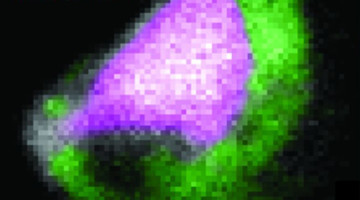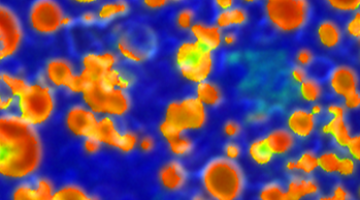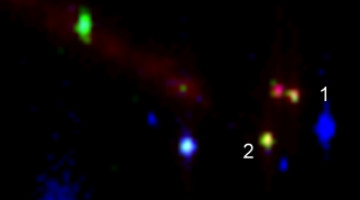Researchers have made significant headway in the quest to convert CO2 into valuable chemical products such as fuels, pharmaceuticals, and plastics. Recent work at the ALS has shown MOFs and COFs as a valuable new class of CO2 reduction catalysts. Read more »![]()
![]()
Aerosol Oxidation Speeds Up in Smoggy Air
To better understand the effects of organic aerosols on climate, pollution, and health, researchers measured aerosol reaction rates at ALS Beamline 9.0.2. They discovered an unexpectedly large acceleration in aerosol oxidation in the presence of anthropogenic pollutants commonly found in smoggy air, a result that could help bring models closer in line with observations. Read more »![]()
![]()
What Goes Up, Must Come Down (and Sometimes Gets Stuck)
High-pressure experiments at Beamline 12.2.2 on ferropericlase—the presumed weakest mineral found in the Earth’s lower mantle—help explain why subducted slabs of Earth’s crust stall at a depth of around 1000 km (~625 miles). Read more »![]()
Decoding Ancient Ocean Acidification Signals from Plankton Shells
Ancient plankton shells can record the physical and chemical state of the ocean in which they grew. Decoding these signals can reveal changes in global climate, atmospheric CO2, and the acidity of the oceans in deep geologic time.
Space Dust Analysis Could Provide Clues to Solar System Origins
New studies of space dust captured by NASA’s Stardust Interstellar Dust Collector have shown that interstellar particles may be much more complex in structure and composition than previously thought. Read more »![]()
![]()
Chloride Depletion in Aged Sea Salt Particles
Elemental and chemical imaging analyses showed that sea salt particles react with water-soluble organic acids in the atmosphere through a unique mechanism which had been overlooked in atmospheric chemistry. The reactions release volatile hydrogen chloride into the atmosphere and leave behind sea salt particles drained of chloride.
Read more »
Direct Kinetic Measurements of a Criegee Intermediate
“Criegee intermediates” are elusive molecules that play a pivotal role in atmospheric chemistry and are also byproducts of key combustion reactions. At the Chemical Dynamics Beamline, the reaction rates of one form of Criegee intermediate was directly measured for the first time, with some surprising results. Read more »![]()
![]()
Molecular Measurements of the Deep-Sea Oil Plume in the Gulf of Mexico
To study the effects of oil spilled from the Deepwater Horizon blowout, researchers collected deep-water samples from across the Gulf of Mexico and analyzied their physical, chemical, and microbiological properties using a variety of techniques, including SR-FTIR. Read more »![]()
![]()
Extracellular Proteins Promote Zinc Sulfide Aggregation
Researchers from the ALS, Berkeley Lab’s National Center for Electron Microscopy (NCEM), and Lawrence Livermore National Laboratory analyzed biofilm samples rich in zinc sulfide and dominated by sulfate-reducing bacteria, which were collected from lead–zinc mine waters.
Read more »![]()
![]()
Particles from Comet 81P/Wild 2 Viewed by ALS Microscopes
NASA’s $200-million, seven-year-long Stardust mission returned to Earth thousands of tiny particles snagged from the coma of comet 81P/Wild 2. Four ALS beamlines and the researchers using them were among the hundreds of scientists and dozens of experimental techniques in facilities around the world that contributed to the preliminary examination of the first samples.
Read more »![]()
![]()
- « Previous Page
- 1
- …
- 5
- 6
- 7







